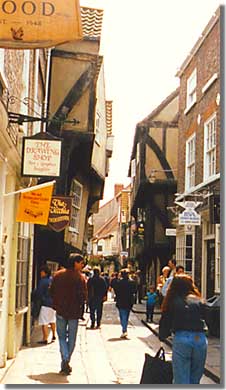
York's Shambles is a rare example of a street identified as far back as Domesday Book. In the Middle Ages the street was used as the butchers' market, its name deriving from an Old English word referring to the stalls from which meat was sold. Shambles were to be found in many of the larger English towns.
The slaughter of livestock and sale of carcasses in York (as elsewhere) created a range of health hazards, prompting city ordinances such as that of 1301, which forbade butchers to sell carcasses or cuts of meat that had already been displayed for sale on their stalls, exposed to the sunlight, for a full day (unless it had been carefully cleaned and salted). Spoiled or poor-quality meat might be given to the city's lepers.
As one of the elements that made up the city fee farm, butchers were required to pay 1d weekly, under the name of "Schameltoll", for the right to slaughter beasts and sell their meat from these stalls. In 1382 the butchers refused for several months to pay this toll and used force to retrieve an item that the city bailiffs had distrained from one of the butchers. The bailiffs responded by successfully suing the butchers.
There remain examples of late medieval buildings in the Shambles, which represents a good example of how houses – topped by overhanging "solars" through which it was hoped that sunlight might be brought through the windows into burgesses' living quarters – were sometimes within arms' reach of each other. The Shambles today is a popular tourist attraction, lined with shops and businesses, often bustling much as it must have in the Middle Ages.
